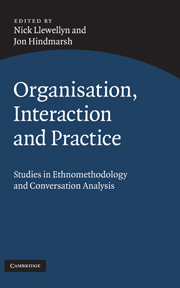Book contents
- Frontmatter
- Contents
- List of contributors
- Preface
- Part I Orientations
- Part II Studies
- 3 A kind of governance: rules, time and psychology in organisations
- 4 On the reflexivity between setting and practice: the ‘recruitment interview’
- 5 The situated production of stories
- 6 Orders of bidding: organising participation in auctions of fine art and antiques
- 7 Some major organisational consequences of some ‘minor’, organised conduct: evidence from a video analysis of pre-verbal service encounters in a showroom retail store
- 8 The work of the work order: document practice in face-to-face service encounters
- 9 The interactional accomplishment of a strategic plan
- 10 Peripherality, participation and communities of practice: examining the patient in dental training
- List of references
- Index
9 - The interactional accomplishment of a strategic plan
Published online by Cambridge University Press: 20 May 2010
- Frontmatter
- Contents
- List of contributors
- Preface
- Part I Orientations
- Part II Studies
- 3 A kind of governance: rules, time and psychology in organisations
- 4 On the reflexivity between setting and practice: the ‘recruitment interview’
- 5 The situated production of stories
- 6 Orders of bidding: organising participation in auctions of fine art and antiques
- 7 Some major organisational consequences of some ‘minor’, organised conduct: evidence from a video analysis of pre-verbal service encounters in a showroom retail store
- 8 The work of the work order: document practice in face-to-face service encounters
- 9 The interactional accomplishment of a strategic plan
- 10 Peripherality, participation and communities of practice: examining the patient in dental training
- List of references
- Index
Summary
Introduction
This chapter draws on a study of organisational members doing their everyday work in a large UK private sector company. It forms part of a programme of work inspired by ethnomethodology (EM) seeking to examine the ways particular members constitute ‘strategy’ and facets of ‘organisation’ alongside a situated identity we know as either ‘senior manager’ or ‘strategist’ (Samra-Fredericks, 2003a, 2003b, 2004a, 2004b, 2005a, 2007). From having audio/video recorded organisational members' naturally occurring interpersonal routines over time and space, in this chapter, I focus on the behind-the-scenes efforts of two senior members refining for the nth time a written draft of their strategy document into a polished version for consumption both internally (employees, executive and the board of a public limited company (PLC)) and externally (City analysts, investment companies, media and the like). This chapter touches on how an annual strategy document was interactionally assembled and, as part of this, how members built elusive and spectacular objects and phenomena such as ‘markets’ and ‘environment’ as well as consolidated claims to knowing. Given that the strategic story is arguably the most costly story to be told in organisations (D. Barry and Elmes 1997; Samra-Fredericks 2003b), real-time studies of the ‘work’ of strategic story writing form an important field of study within organisation studies. However, fine-grained studies of everyday strategic management practice-as-interactionally-done as proposed here remain rare.
Information
- Type
- Chapter
- Information
- Organisation, Interaction and PracticeStudies of Ethnomethodology and Conversation Analysis, pp. 198 - 217Publisher: Cambridge University PressPrint publication year: 2010
Accessibility standard: Unknown
- 16
- Cited by
